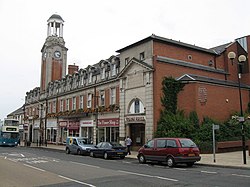Spennymoor Town Hall
 From Wikipedia - Reading time: 5 min
From Wikipedia - Reading time: 5 min
| Spennymoor Town Hall | |
|---|---|
 Spennymoor Town Hall | |
| Location | High Street, Spennymoor |
| Coordinates | 54°41′54″N 1°36′10″W / 54.6984°N 1.6028°W |
| Built | 1916 |
| Architect | G. T. Wellburn |
| Architectural style(s) | Edwardian Baroque style |
Spennymoor Town Hall is a municipal building in Spennymoor, County Durham, England. The town hall is the meeting place of Spennymoor Town Council.
History
[edit]After population growth associated with the increasing number of coal mines in the town, the local board of health, which had been formed in 1864,[1] established its offices in a market hall which was built in the High Street and completed in 1870.[2][3] The market hall was a single storey structure with a small central tower with a pyramid-style roof.[2] After the formation of Spennymoor Urban District Council in 1894,[4] civic leaders decided to demolish the building and to erect a more substantial structure on the same site.[1]
Construction of the new building began in 1913;[1] the architect was G. T. Wellburn[5] and the contractor J. Miller of South Shields.[6] The new building included the Town Hall itself (a public hall measuring 84 ft (26 m) by 40 ft (12 m) and designed to seat 850 people) along with municipal offices and an adjacent market hall, measuring 141 ft (43 m) by 39 ft (12 m) (since demolished). It was designed in the Edwardian Baroque style, was built in red brick with stone dressings at a cost of £18,000 and was completed in 1916.[1] The design involved an asymmetrical main frontage with fifteen bays facing onto the High Street. The second/third bay from the left had a rusticated arch which originally led to the market hall beyond. The fifth bay from the left, which slightly projected forward and was faced in stone, featured a doorway on the ground floor with the town's coat of arms in the tympanum, a tall window on the first floor and a clock tower with a roof lantern above. The final bay, pedimented and faced entirely in stone, was the entrance to the public hall. The other bays featured shops on the ground floor, baroque style windows on the first floor and pedimented baroque style windows at attic level. Internally, other than the hall, the principal room was a circular and domed council chamber, which was panelled.[7]
The building continued to serve as a meeting place for Spennymoor Urban District Council for much of the 20th century but ceased to be the local seat of government after the enlarged Sedgefield District Council was formed in 1974.[8] The town hall was refurbished in 1990[1] and continued to be used by Spennymoor Town Council as their meeting place.[9]
The Durham Miners Museum, which was formed when a group of former miners started exhibiting their collection of artefacts in 1999 and which had been based in a small room at Thornley Community Centre since 2005,[10] relocated to more substantial facilities in the town hall in October 2011.[11] A simulation of a typical mine tunnel, which could be explored by visitors, was put on display in the museum April 2014.[11]
With financial support from the Spennymoor Area Action Partnership,[12] part of the first floor of the town hall was converted for use as an art gallery in 2011.[13] The gallery was named the Bob Abley Art Gallery, in March 2014, after a former teacher and curator, Bob Abley, who helped establish the gallery.[14] A room within the gallery was subsequently dedicated to exhibiting paintings by the locally-born artist and former miner, Norman Cornish.[15]
References
[edit]- ^ a b c d e "A glance back at Spennymoor". Spennymoor Town Council. Retrieved 25 January 2021.
- ^ a b "Spennymoor History". Tudhoe & Spennymoor Local History Society. Retrieved 25 January 2021.
- ^ "Ordnance Survey Map". 1897. Retrieved 25 January 2021.
- ^ "Spennymoor UD". Vision of Britain. Retrieved 25 January 2021.
- ^ The Building News and Engineering Journal. Vol. 104. 1913. p. 557.
- ^ "The new municipal building of the Spennymoor Urban Council". The Architect and Contract Reporter. XCV: 156. 25 February 1916.
- ^ "Meeting to plan Spennymoor's Remembrance activities". Northern Echo. 6 January 2018. Retrieved 25 January 2021.
- ^ Local Government Act 1972. 1972 c.70. The Stationery Office Ltd. 1997. ISBN 0-10-547072-4.
- ^ "Full Council Meetings". Spennymoor Town Council. Retrieved 25 January 2021.
- ^ "County mining museum finds permanent home". Northern Echo. 4 July 2005. Retrieved 25 January 2021.
- ^ a b "Durham Mining Museum, in Spennymoor, has opened its mock mine". Northern Echo. 26 April 2014. Retrieved 25 January 2021.
- ^ "Proms, penalties and projects get funding". Northern Echo. 24 March 2011. Retrieved 25 January 2021.
- ^ "Pit tribute painting donated to Spennymoor gallery". Northern Echo. Retrieved 25 January 2021.
- ^ "Spennymoor Town Hall gallery honour for Bob Abley". Northern Echo. 21 March 2014. Retrieved 25 January 2021.
- ^ "A hub of culture and creativity". Welcome to Durham Tees Valley. 16 April 2021. p. 51. Retrieved 25 January 2021.
 KSF
KSF